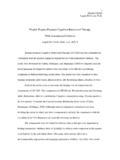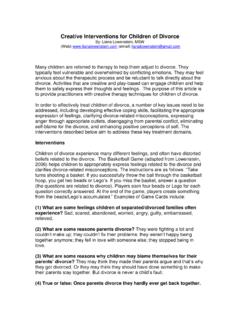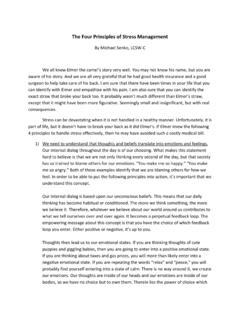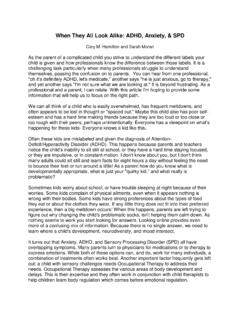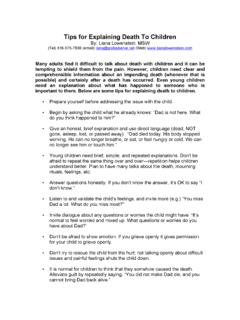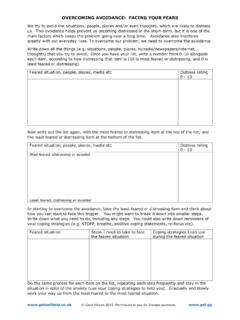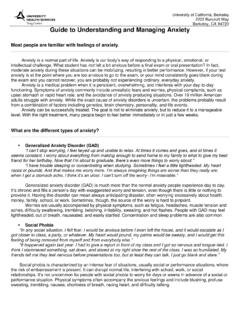Transcription of Creative CBT Interventions for Children with Anxiety Liana …
1 Creative CBT Interventions for Children with Anxiety Liana Lowenstein, MSW Many Children are referred to therapy to help them cope with Anxiety . They may feel apprehensive about the therapeutic process and be reluctant to talk directly about their fears and worries. Activities that are Creative and play-based can engage Children and help them learn skills to manage Anxiety . The purpose of this article is to provide clinicians with Creative CBT techniques for Children with Anxiety symptoms and disorders. COGNITIVE-BEHAVIORAL THERAPY Cognitive-Behavioral Therapy (CBT) is the most empirically supported treatment for treating childhood Anxiety .
2 In CBT, the clinician teaches the child adaptive coping skills and provides practice opportunities to develop a sense of mastery over Anxiety symptoms or situations that are associated with distress and impairment (Connolly, & Bernstein, 2007). The Interventions contained herein address the key components of CBT for childhood Anxiety , namely, psychoeducation, somatic management skills training, cognitive restructuring, exposure, and relapse prevention. THE RATIONALE FOR THE USE OF A PLAYFUL CBT APPROACH Creative , play-based activities, presented within the context of an empathically attuned therapeutic relationship, engage Children and enhance the effectiveness of CBT.
3 Play has a critical role in CBT with Children , as it provides an accessible, developmentally appropriate context for Children to participate in therapy (Knell & Dasari, 2011; Podell et al., 2009; Shelby & Berk, 2009). Blending structured play techniques with CBT allows for effective implementation of CBT while retaining its theoretical underpinnings. Pleasurable, playful activities are known to lower levels of stress chemicals, enabling Children to deal more successfully with stressful situations (Plummer, 2012, p. 30). When Children are engaged in games and playful activities, they are not only having fun but they are also relaxing and learning new skills.
4 Furthermore, in order to obviate the possibility that CBT is dull and boring to Children , it is incumbent upon cognitive behavioral therapists to develop Creative and engaging ways to deliver these skills to Children (Friedberg et al., 2000, p. 190). Developmentally appropriate and fun CBT activities are effective as Children understand them, enjoy them, and are more motivated to participate in sessions. Interventions Psychoeducation Psychoeducation serves central key functions in CBT. The main purpose is to inform Children and their parents about Anxiety , sources of Anxiety , symptoms of and common reactions to Anxiety , and treatment approaches.
5 This knowledge normalizes the client s experience of Anxiety and empowers them to deal with Anxiety in an optimal way. 2 When clients learn factual information about Anxiety , misinformation is dispelled, and Children and parents learn that others have faced similar challenges. As well, providing information on the effectiveness of CBT gives clients a sense of hope. The Crumpled Paper Throw game (Lowenstein, 2016) is an active and engaging approach to psychoeducation, and thus it maintains Children s interest and helps them to absorb the material. The practitioner explains the game as follows: Crumple a piece of paper into a ball, stand behind the tape line, and throw the paper ball toward the hoop I will make with my arms.
6 If you get the crumpled paper through the hoop, you earn 1 point. If you miss, I will ask you a question. You get 2 points for each question you answer correctly. If your answer is incorrect, I will read the answer to the question, and then you will have the chance to answer again and earn 2 points. At the end of the game, trade in points for prizes: 1 10 points = 1 prize; 11 or more points = 2 prizes. The questions define Anxiety , physiological responses to Anxiety , and the process and benefits of CBT. Examples of questions include: Question: What is Anxiety ? Answer: Anxiety is a feeling of worry or nervousness.
7 Everyone gets anxious or worried sometimes. When kids worry a lot, it can be hard for them to feel happy and enjoy certain activities. Kids need help for Anxiety when they worry much of the time, and when their fears or worries stop them from having fun or from doing normal activities. Question: True or Not True: Some Anxiety can be helpful. Answer: True. Anxiety can actually be helpful because it can protect people from real danger. For example, if you re crossing the street and a car comes fast toward you, Anxiety would alert you to this danger so you can get out of the car s way.
8 Question: What does Anxiety feel like in the body? Answer: When you feel anxious or worried, you might get a sore tummy or have diarrhea. Your body might get hot and sweaty. You might feel dizzy or shaky, or even feel like you re going to throw up or faint. Your heart might pound really fast and you might have a hard time breathing. Therapy can help you learn ways to handle Anxiety so your body doesn t feel so bad. Question: What is cognitive behavioral therapy (CBT)? Answer: Cognitive behavioral therapy, or CBT for short, is a type of therapy to help people with Anxiety . In CBT, kids learn special skills to help them cope with worries and fears.
9 CBT has proven to be the best way to help kids deal with Anxiety . Question: What is gradual exposure? Answer: Gradual exposure is part of CBT. Gradual exposure involves facing a fear a little at a time until the fear is not so scary anymore. Don t worry: We will only start this part of therapy when you are ready. We will make a plan together so you feel okay with it. After a while, your Anxiety will lessen and you will feel calmer and better. Question: True or Not True: The goal of therapy is to make Anxiety go away. Answer: Not True. Remember, some Anxiety is normal and helpful, so we need a certain amount of Anxiety .
10 The goal of therapy is to help kids handle fears and worries so Anxiety does not stop them from having fun or from doing normal activities. 3 Parents play the game along with the child so they can learn together. Presumably, clients will not know the answers to many of the questions. However, they have the opportunity to learn the answers when the practitioner reads them aloud and can then earn points for providing the correct response. This approach encourages Children to listen attentively when correct answers are read aloud, and facilitates learning and integration of the material. Optional questions can be added to the game that define specific Anxiety disorders ( , What is Selective Mutism?)
